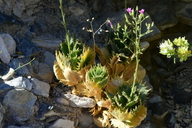Taxon Report
Aliciella ripleyi (Barneby) J.M. PorterRipley's aliciella |
 © 2020 Joey Malone |
Taxon Summary
Aliciella ripleyi, commonly known as Ripley's aliciella, is a perennial herb in the Polemoniaceae that is found in California and elsewhere. It occurs within Mojavean desert scrub, growing at elevations from 305 to 1950 meters. Aliciella ripleyi is ranked 2B.3, Plants Rare, Threatened, or Endangered in California, But More Common Elsewhere; Not very threatened in California.Classification
|
Scientific Name: |
Aliciella ripleyi (Barneby) J.M. Porter |
|
Common Name: |
Ripley's aliciella |
| Family: | Polemoniaceae |
| Element Code: | PDPLM041E0 |
| USDA Plants Symbol: | ALRI3 |
|
Synonyms/Other Names: |
|
Ecology and Life History
| Lifeform: | perennial herb |
| Blooming Period: May-Jul | May-Jul |
| Elevation: | 305-1950 (1000-6400) |
| General Habitats: | Mojavean desert scrub |
| Microhabitat: | |
| Microhabitat Details: |
Conservation Status
| CA Rare Plant Rank: | 2B.3 |
| Global Rank: | G3 |
|
State Rank: |
S2 |
| State List: | None |
| Fed List: | None |
| Other Status: | |
|
CRPR Changes: |
|
Occurrence Data from the CNDDB
| Total Occurrences: | 22 |
| Element Occurrence Ranks: | |
| Excellent (A) | 1 |
| Good (B) | 2 |
| Fair (C) | 1 |
| Poor (D) | 0 |
| None (X) | 0 |
| Unknown (U) | 18 |
| California Endemic: False | |
| California Counties and Islands: Name (Code) | |
| Inyo (INY), San Bernardino (SBD) | |
| Quads: Name (Quad Code) | |
| Bee Springs Canyon (3611871), Blackwater Mine (3511577), Bole Spring (3611633), Dantes View (3611626), Eagle Mtn. (3611623), East of Echo Canyon (3611645), East of Ryan (3611635), Echo Canyon (3611646), Emigrant Canyon (3611742), Galena Canyon (3611618), Hanaupah Canyon (3611628), Hanging Rock Canyon (3711726), Horse Thief Canyon (3711737), Little Lake (3511788), Nelson Range (3611756), Panamint (3611711), Tecopa (3511672), Telescope Peak (3611721), Thimble Peak (3611771), West of Shenandoah Peak (3511576), Westend (3511764), Wildrose Peak (3611731) | |
Threat List Data from the CNDDB
| Threat List Total: | 4 | |
| EOs with Threat Listed: | Total EOs | % of EOs |
| 5 | 23 % | |
| Mining | 2 | 9% |
| Road/trail construction/maint. | 2 | 9% |
| Grazing | 1 | 4% |
| Non-native plant impacts | 1 | 4% |
Citation
California Native Plant Society, Rare Plant Program. 2025. Rare Plant Inventory (online edition, v9.5.1). Website https://www.rareplants.cnps.org [accessed 22 September 2025].